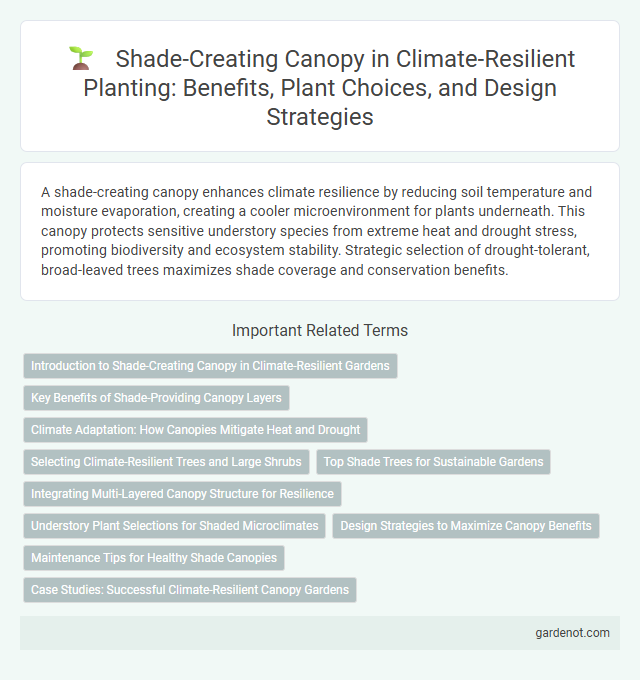A shade-creating canopy enhances climate resilience by reducing soil temperature and moisture evaporation, creating a cooler microenvironment for plants underneath. This canopy protects sensitive understory species from extreme heat and drought stress, promoting biodiversity and ecosystem stability. Strategic selection of drought-tolerant, broad-leaved trees maximizes shade coverage and conservation benefits.
Introduction to Shade-Creating Canopy in Climate-Resilient Gardens
Shade-creating canopies play a crucial role in climate-resilient gardens by reducing soil temperatures and conserving moisture, which helps plants withstand heat stress and drought conditions. Trees with dense foliage such as oaks, maples, and honey locusts provide natural cooling effects through transpiration and leaf coverage, creating microclimates beneficial for understory vegetation. Integrating shade-providing species enhances biodiversity, improves air quality, and supports sustainable urban landscaping efforts aimed at climate adaptation.
Key Benefits of Shade-Providing Canopy Layers
Shade-providing canopy layers reduce soil temperature and moisture evaporation, enhancing plant growth and water conservation in climate-resilient planting systems. They create microclimates that protect understory crops from extreme heat and UV radiation, promoting biodiversity and improving overall ecosystem stability. Canopy layers also mitigate wind impact, reducing erosion and supporting long-term agricultural productivity.
Climate Adaptation: How Canopies Mitigate Heat and Drought
Shade-creating canopies play a crucial role in climate adaptation by significantly reducing surface temperatures and conserving soil moisture during heatwaves and droughts. Tree canopies intercept solar radiation, lowering ground heat absorption and mitigating urban heat island effects while also enhancing evapotranspiration processes that improve local humidity levels. Strategic planting of drought-tolerant species within these canopies further strengthens resilience by maintaining cover and microclimates essential for ecosystem stability under extreme weather conditions.
Selecting Climate-Resilient Trees and Large Shrubs
Selecting climate-resilient trees and large shrubs for shade-creating canopies ensures long-term survival under changing weather conditions, minimizes water usage, and supports local biodiversity. Species such as Quercus virginiana (live oak), Acer rubrum (red maple), and Juniperus virginiana (eastern red cedar) are known for their drought tolerance, pest resistance, and adaptability to extreme temperatures. Proper selection enhances urban heat island mitigation while providing sustainable shade that protects soil and reduces energy consumption.
Top Shade Trees for Sustainable Gardens
Top shade trees such as oak, maple, and jacaranda provide essential canopy cover that reduces soil temperature and conserves moisture, enhancing garden sustainability. These trees support biodiversity by offering habitat to various bird and insect species while improving air quality through carbon sequestration. Selecting native, drought-resistant species ensures long-term climate resilience and minimal maintenance in sustainable garden designs.
Integrating Multi-Layered Canopy Structure for Resilience
Integrating a multi-layered canopy structure enhances climate resilience by promoting biodiversity and optimizing microclimates within planting areas. Shade-creating canopy layers reduce soil temperature, conserve moisture, and protect understory plants from extreme weather stress. This approach supports ecosystem stability and improves overall plant health under variable climatic conditions.
Understory Plant Selections for Shaded Microclimates
Selecting understory plants for shaded microclimates requires species with high shade tolerance and moisture retention capabilities, such as ferns, hostas, and woodland phlox. These plants thrive beneath shade-creating canopies by enhancing soil health, reducing erosion, and supporting biodiversity in climate-resilient landscapes. Integrating diverse understory vegetation promotes microclimate stability and improves ecosystem resilience against temperature fluctuations and drought conditions.
Design Strategies to Maximize Canopy Benefits
Design strategies for shade-creating canopies emphasize selecting fast-growing, drought-tolerant tree species like Quercus virginiana and Celtis laevigata to enhance microclimate regulation. Proper spacing and layering of canopy trees improve airflow and maximize shade coverage, reducing surface temperatures by up to 10degF. Integrating native understory vegetation beneath the canopy also supports soil moisture retention and biodiversity, reinforcing overall climate resilience.
Maintenance Tips for Healthy Shade Canopies
To maintain healthy shade canopies, regularly inspect trees for pests and diseases, ensuring early detection and treatment. Prune branches to promote airflow and sunlight penetration, preventing fungal growth and encouraging robust foliage. Adequate watering, especially during dry periods, supports root health and maximizes canopy density for effective climate resilience.
Case Studies: Successful Climate-Resilient Canopy Gardens
Case studies of successful climate-resilient canopy gardens demonstrate significant improvements in urban heat reduction and biodiversity enhancement. Projects in cities like Singapore and Nairobi showcase species selection and strategic planting techniques that optimize shade creation while conserving water. These examples highlight resilient tree species such as Ficus and Albizia, which thrive under climate stress and support local ecosystems.
Shade-creating canopy Infographic

 gardenot.com
gardenot.com